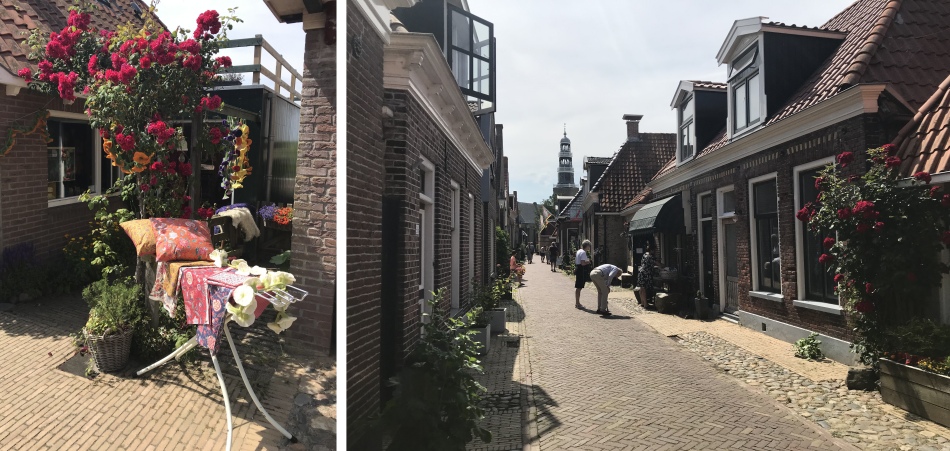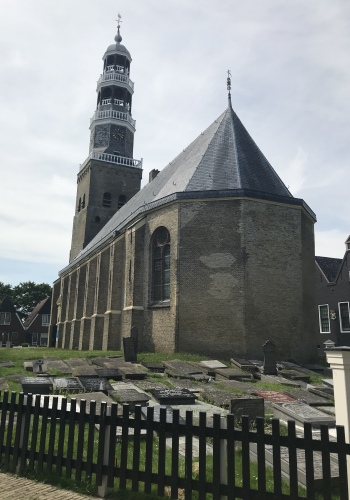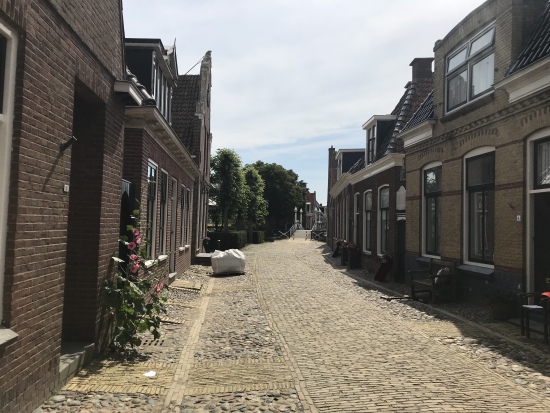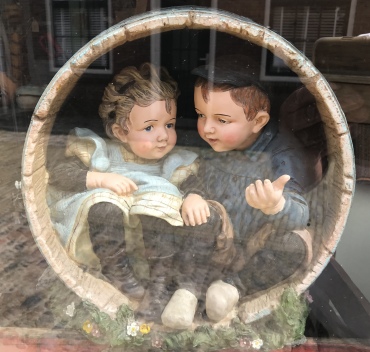As we took on board more water, a German chap showed me the magic button which enabled water to come out of the tap - turn the tap on then find the magic button to press. We had a brief exchange with him and his wife, and the Dutch couple who were sharing the same chartered yacht. They were also travelling to Hindeloopen today. We wished them a safe trip, and then set about extracting ourselves from the box before heading out into the Ijsselmeer.
It was a glorious sail with the hot sun beating down upon us. We picked up another rescue operation on the VHF, but again we had no idea where it was. After four hours of sailing under a merciless sun, we passed Stavoren and approached Hindeloopen, recognisable from a distance by its leaning church tower. In no time at all we were safely moored up.
We took a long walk around the perimeter of the large marina to get to the exit. We took advantage of a small stall selling cooked fish and cold drinks, and enjoyed a drink under a parasol. The heat was oppressive. Then I spotted a boat pulling alongside the harbourmasters pontoon. It was the German/Dutch boat we had seen in Enkhuizen. I took their ropes while they checked in.
We partook in a brief stroll around the small town. We passed the small but busy Hylper Haven Marina (Hindeloopen Frisians were natively called Hylpers), the Sylhuis, the lockkeeper's house, together with the leaf bridge in front of it, and the Liars' Bench, where male inhabitants of Hindeloopen still meet and tell tall stories.
 Walking Down Buren |
 Grote Kerk |
The shipping trade with Scandinavia, the Baltic states and Russia, together with good relations with the metropolis Amsterdam, brought the population of Hindeloopen a great prosperity. The 17th and 18th centuries were especially golden times. At that time, the people of Hindeloopen spent a lot of money in Amsterdam on precious fabrics and objects, which were supplied through the Dutch East India Company (VOC). The rich town developed in those days her own traditional costumes and a completely individual style with colourful painted walls and furniture. The flourishing trade came to an end in the 19th century when the merchants moved to Amsterdam. Hindeloopen became somewhat impoverished and people were forced to make a living from fishing. Nowadays, tourism features heavily in the town's economy.
The town was a maze of delightful, narrow, cobbled streets, festooned with flowers and criss-crossed by small canals. Walking down the main drag, a narrow street awash with arts and crafts shops, pancake cafes, and a sprinkling of museums to provide interest for the enquiring mind, we soon came across the Grote Kerk. Its tall, leaning tower is visible from miles out over the Ijsselmeer. In the Middle Ages a parish church existed in Hindeloopen, but was destroyed in 1570. It was rebuilt in 1593. During the 17th century the population of Hindeloopen grew significantly, and there was a need for a larger building. The old church was demolished and the foundation was laid for a new church building in 1632. More than 25 years later, the church was extended with a south aisle. It was only in 1683 when the tower was equipped with bells. During the years 1970-1975 both the interior and exterior restorations were carried out, and the tower, hanging well off balance, was somewhat "rectified".
 Walking up Nieuwstad |
Off they went. I was dead in this heat and went for a lie down, followed by a refreshing shower. Revitalised, we headed into town and stopped for a beer at the Cafe de Boekanier, Rex always insisted we kept our fluid levels topped up. Fully topped up, we left; we had pre-booked a table we had arranged on our earlier stroll. A young woman dashed out of the bar. Oh my God, I had forgotten to pay for the beer. I was ever so embarrassed, and paid her immediately with a grovelling apology. Senior moments catching up with me!
 Shop Window |
Back in the marina we watched small swallows swoop effortlessly about and perch on the standing ropes within the boxes. To think that these small birds will soon be making their marathon flights to South Africa.
Rex did his normal inspection of the boats for sale in the marina. The dimensions stated on the for sale signs, and the actual dimensions of the vessels did not seem to tie up. He was not tempted; he would need to consult his better half first.
Back at the boat I met a German couple and their three children. They had hired the boat for a week to see if their children enjoyed it. By all accounts the youngsters were over the moon with it. Tomorrow they were heading to Medemblik. "You must take your children on the steam train trip to Hoorn!," I urged.
Sleep beckoned.
